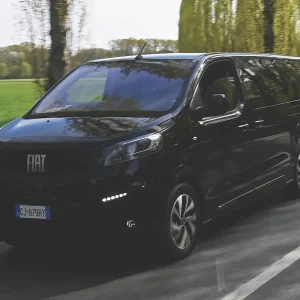What is a tipper van?
Let’s start at the beginning.
In its most common form, a tipper is a light commercial vehicle with either a single- or double-cab at the front, and – more importantly – a flat bed at the back, which is open and has low sides plus a hinged tailgate.
The load to be transported is carried on the flat bed and at the destination discharged, or tipped out. How? The ram mechanism raises the front of the bed at an angle so that the load is tipped out to the rear of the vehicle.
But that’s just one type because there are also ‘three-way’ tippers, which allow tipping to either side as well to the rear, while Citroen points to variants such as ‘cage tippers’, which are useful for carrying loads such as leaves that would otherwise blow away. The enclosed cage top section ensures that the load stays in the body, enabling the moving of, as Volkswagen says, a higher, albeit lighter, load.
Who buys tipper vans?
Tippers are bought by a variety of customers. As well as construction businesses, they are purchased by companies involved in the agricultural, forestry and horticultural sectors, as well by utility companies and local authorities.
What can I carry in a tipper?
Armed with the above knowledge, it will come as no surprise to find out that typical bulk loads that are delivered and offloaded in a tipper include loose building materials such as hard core or Tarmac, plus rubble, sand, gravel, cement, soil, tree waste and litter.
Be careful, however, not to carry anything that can be damaged in the act of tipping it out!
How to choose the right model for you
Right, now we’ve got the basics out of the way, let’s get down to the nitty-gritty of how you go about making sure you choose the model that best meets your needs.
VFS lists the key considerations in order of importance as:
- Payload
- Durability
- Price
- Warranty
Citroen agrees that payload is often the most important factor for tipper users, although as it points out, other requirements might trump payload, such as needing the durability of a steel body for transporting stone because it can take the knocks when a lighter alloy body could provide a better payload.
Volkswagen, however, believes it’s possible to strike a balance between payload and durability, and says thatwhen it comes to making tippers, it tries “to achieve maximum payload without compromising on materials/strength”.
Once you’ve decided which factors are most important for your business, it’s time to consider the…
Essential features and nice-to-haves
Volkswagen says most people want:
- a tip-over and tip-through function at the rear (where the tailboard is either hinged at the bottom of the tipper bed for loads to pass over, or at the top for loads to pass beneath)
- bulkhead protection, which protects the cab and usually comes as standard.
VFS lists a further three features as being essential:
- an adequate tipping ram mechanism to push the bed up to release the load
- a well-designed load bed with good anti-corrosion standards
- retaining boards to keep the load contained.
Citroen, though, places an emphasis on safety, and its must-haves include:
- appropriate instructions
- operator training
- a body prop, which is a device that ensures the safety of personnel carrying out routine checks and maintenance of components and structures underneath the body when the body is in the tipped position.
Although not essential, Citroen also highlights the availability of remote controls, saying that “many tippers come with a wander lead or wireless remote control so that the operator can control the tipping effectively from behind the vehicle”, while further options mentioned by Volkswagen include “small cranes to lift loads on to the bed, steps and handles to assist getting on to the platform, towbars, and tool storage”.
I’m ready to buy, so where should I go?
As VFS states: “All the major LCV vehicle manufacturers either have a vehicle body programme or their dealers have designated convertors.”
Volkswagen, for example, offers Engineered to Go tippers of a standard specification that can be ordered like any other van through its Van Centres.
The company also offers bespoke tippers tailored to customers’ requirements via its Engineered for You programme.
There is a third option, too, as Volkswagen explains: “It’s also possible for the customer to order a base vehicle and then convert it himself. We would, however, recommed doing it through a Van Centre because with our approved Recognised Converter programme customers have a single point of contact, single invoice, warranty that covers vehicle and conversion, and peace of mind that the Van Centre will handle any issues that arise when the vehicle is in service.”
While Citroen says bodybuilders can produce a body to a required specification to fit a base chassis cab, it warns customers to “be sure that it carries European Whole Vehicle Type Approval”.
Like Volkswagen, Citroen says the best way to acquire a conversion is from a vehicle manufacturer’s conversion range, such as its Ready to Run programme.
“This will carry a full warranty on the conversion to match the warranty of the base vehicle and can be ordered from any Citroen dealer,” says the manufacturer. “Citroen uses carefully selected bodybuilders to produce its Ready to Run conversions. All are certified and comply with the required regulations.”
Actually, do I really need to buy one?
While companies like Volkswagen offer finance options on conversions if you want to own a tipper van, Citroen says it might be worth considering rental as a solution “for occasional or one-off needs”.
Leasing is also a possibility, and Citroen says it might be the route for comparatively light-use operations such as a cage tipper or for occasionally moving sand and cement. However, it warns: “Leasing for heavy use could prove expensive if the body is likely to have a hard life and sustain damage.”
Are tipper vans easy to sell on?
This is an easy one to answer as all three companies agree that there is always a market for tippers provided they have been properly maintained and have not suffered significant damage.
Are there any downsides to acquiring a tipper van?
Not much, really, apart from the obvious, such as you could be stuck if the tipping mechanism fails, and you could have a far more serious problem if, as Citroen rightly highlights, you fail to ensure safe operation. So, as the manufacturer advises, make sure to:
- only tip on a solid, even surface where there is no risk of the vehicle turning over
- use the body prop if the body is left in the raised position
- carry out proper maintenance and safety inspections on the tipping mechanism to ensure compliance with the appropriate health and safety regulations such as the Provision and use of Work Equipment Regulations (PUWER) and the Lifting Operations and Lifting Equipment Regulations (LOLER).
If you do have a mechanical issue, though, go back to your supplier. Volkswagen, for instance, offers a one-stop-shop to solve any issues with, they say, minimum inconvenience for the owner, while they “will liaise with the converter to ensure the customer does not get ‘stuck in the middle’”.
So to conclude, if you’re in the market for a vehicle that, as Citroen, Volkswagen and VF say…
- can “speed up operations and reduce manual work”
- doesn’t “require other feature options to unload the cargo”
- and is “more versatile than a dropside van”
…then there is “no substitute” for a tipper.





